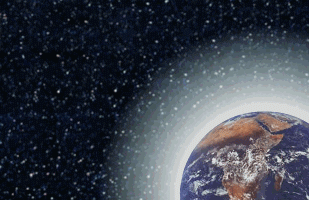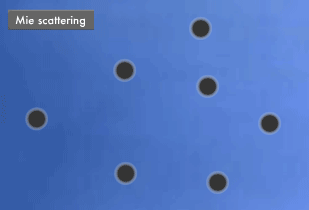Canon Science Lab
Why is Sky Blue? Why is the Sunset Red?
If the air is transparent and sunlight is colorless, then why does the sky look blue? And why does the sky become red at dusk and dawn?
Blue and red are two components of light. Blue light has a short wavelength, while the wavelength of red is long. The shorter the wavelength, the stronger the light scattered. (Blue light is strongly scattered.)
During the day, the sky looks blue because of this strong scattering. At dawn and dusk, light passes through the atmosphere for a longer period, which scatters blue light waves. Red and orange, with their longer wavelengths, dominate because they scatter less, which is why the sky looks red early in the day and when the sun is setting.
Light Scattering
Light comprises waves. When looking at waves of water, if plane ripples hit an obstacle larger than their wavelength, you will observe them bending around the edge of the obstacle. Light waves show the same phenomenon, called light diffraction, when they bend around an obstacle larger than their wavelength. Meanwhile, when these waves of light collide with particles and molecules smaller than their wavelengths in the atmosphere, they cause the particles and molecules to "relay" their wave motion, radiating light in the same wavelength into the surrounding air.

Scattering Occurs in Molecules in the Air
Until the end of the 19th century, people believed that atmospheric dust and water droplets caused light to be scattered. But dust and water droplets are larger than the wavelength of light. Light is scattered when it hits an object that is smaller than its wavelength. John William Strutt Lord Rayleigh (1842-1919), an English physicist, concluded that light is scattered when it hits molecules of hydrogen and oxygen in the atmosphere. There are various types of scattering, but the term for the effect described above is called Rayleigh scattering.

Blue Light Is Scattered Strongly
As mentioned before, light incorporates colors such as blue and red. Common light combines various kinds of light, each of which has its own wavelength. The individual components of light are called the spectrum. Blue light has a short wavelength; red light a longer wavelength. The sky looks blue because blue light is scattered far more than red light, owing to the shorter wavelength of blue light. (Violet light, which has an even shorter wavelength, cannot be seen because the human eye is not very sensitive to violet light.)

The sky is red at dawn and dusk. Because at these times sunlight travels further through the atmosphere than at other times of the day, blue light is scattered more. Reds and oranges are scattered less, so these colors appear with greater intensity to our eyes.
There Are Various Types of Scattering Phenomena
In Rayleigh scattering, the efficiency of scattering is inversely proportional to the fourth power of the wavelength. Red light has double the wavelength of blue light, and is therefore scattered 16 times less. Rayleigh discovered that scattering is strongest in the direction light travels, becoming half at right angles to the incident direction of light. At noon, the sun is directly above. At this time, the sky looks blue because the blue light scattering is strongest to the human eye.

Another phenomenon worth knowing about is Mie scattering. This occurs when light hits a water drop, aerosol, or other particle in the atmosphere whose diameter is around the same as the wavelength of the light. In that case, there is no relationship between scattering strength and wavelength, which is why clouds look white and the sky also seems whitish when polluted.
